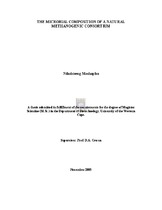| dc.contributor.advisor | Cowan, Donald A. | |
| dc.contributor.author | Mashaphu, Nthabiseng | |
| dc.contributor.other | Dept. of Biotechnology | |
| dc.contributor.other | Faculty of Science | |
| dc.date.accessioned | 2013-06-18T07:31:21Z | |
| dc.date.available | 2007/04/16 15:36 | |
| dc.date.available | 2007/04/16 | |
| dc.date.available | 2013-06-18T07:31:21Z | |
| dc.date.issued | 2005 | |
| dc.identifier.uri | http://hdl.handle.net/11394/1448 | |
| dc.description | Magister Scientiae - MSc | en_US |
| dc.description.abstract | Wetlands account for approximately 20% of annual global methane emissions. Many wetlands receive inputs of organic matter, nutrients, metals and various toxic compounds from adjacent agricultural and industrial areas. The present study aimed to investigate the microbial composition of a natural methanogenic consortium. A consortium-based molecular approach to study diversity of methanogenic microbial communities in a natural wetland at the primary inflow was used. Key microorganisms of a nethane producing consortium were identified. Extracted high molecular mss DNA ws analysed by PCR combined with denaturing gradient gel electrophoresis and subsequent sequencing of 16S rDNA. This study was also aimed to identify syntrophic microorganisms in the wetland system. The data obtained suggest a well established syntrophic relationship within the wetland. | en_US |
| dc.language.iso | en | en_US |
| dc.publisher | University of the Western Cape | en_US |
| dc.subject | Methanobacteriaceae | en_US |
| dc.subject | Microbial populations | en_US |
| dc.title | The microbial composition of a natural methanogenic consortium | en_US |
| dc.type | Thesis | en_US |
| dc.rights.holder | University of the Western Cape | en_US |
| dc.description.country | South Africa | |

